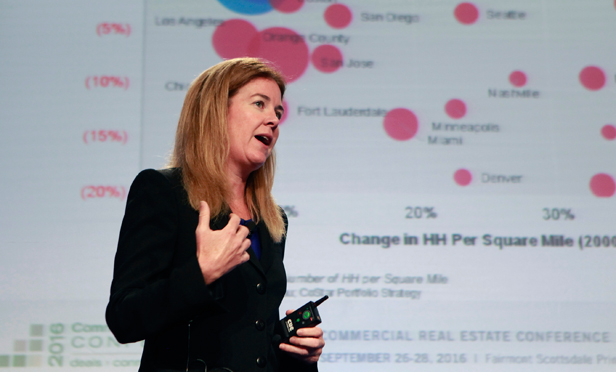 Mulvee: “We are starting to add some of those second incomes back into the workforce.”
Mulvee: “We are starting to add some of those second incomes back into the workforce.”
SCOTTSDALE, AZ—It may be the most pressing question for commercial real estate professionals: What does the future hold? Suzanne Mulvee, director of research, CoStar Group, addressed upcoming trends during the “Keynote General Session: What’s Ahead? The Economy, The Market and Your Investments” at NAIOP’s Commercial Real Estate Conference 2016, held at the Fairmont Scottsdale Princess.
Mulvee’s perspective: “Things look good, but there are cracks in the veneer.”
“Corporate profits are falling; business investments are falling. Interest rates will probably rise, though the Fed is more dovish than hawkish,” said Mulvee. “Even though profits are down, businesses want to hire and wages are rising in some areas. In the search for yield, liquidity is high, pricing is higher, but capital is likely to remain aimed at commercial real estate.”
But the US has seen five consecutive quarters of profit decline without a decline in employment. Mulvee cautions “the last time we saw that was in 1987,” harkening back to the Black Monday crash. She suggested potential causes: “It could be the energy sector, it could be multinational activities abroad. And we may see a pullback in hiring after all, or layoffs which could contract profits.”
“Baby Boomers are being replaced by Echo Boomers,” said Mulvee. “And because of their preferences, we have fewer bodies coming in and demanding real estate. Demographics are destiny and we should see a slow-growth economy for the next 20 years. It’s difficult to imagine the growth we’ve been used to over the next few decades. It’s an uber-tight market: space in newer assets is loosening, but still tight.”
As developers search for greater growth by exploring mega trends, they look to secondary and tertiary markets. Mulvee believes the current lack of construction will set the market up for a different cycle. “It’s an opportunity for value-add. The issue remaining is pricing. Investment will chase select assets, risk-taking will increase. There will be bad deals made.”
Median income continues to decline in suburban markets where two-income households have “been destroyed,” according to Mulvee, “but we are starting to add some of those second incomes back into the workforce. This will have huge implications, especially in retail.”
Additions to existing multifamily stock are very large in some metro areas, said Mulvee. “So this begs the question: Is construction peaking?” Regarding the price per square foot in multifamily, she noted, “In the suburbs there is very little new construction. The problem is the amount concentrated in small locations and units pushing against profitability ceiling. Eighty-eight percent of all units underway require an income of $75,000, which means renters by choice. We have to ask: How deep is that pool?”
Another key economic question: What happens when interest rates rise? Mulvee explained: “Typically the Fed raises interest rates when we see economic growth, but I’m not worried about rising cap rates. We’re seeing good rent growth and tracking construction coming out of the ground. There is growth and demand for Class A, which has been leaps and bounds ahead of other asset classes.”
Mulvee has concerns about construction in the technology sector and stated that supply has fallen off, citing sluggish growth and fewer options.
The office realm is likewise looking down, according to Mulvee. “New space is 50 percent of 2007 levels. There are fewer choices than in the last 16 years, though there are opportunities in value-add.”
Retail received some mixed attention from Mulvee: “At high-quality locations, things look stronger. But there is no activity at the bottom of the market; the patient is dead. The top of the market is seeing high demand and rent growth with store closures in weak locations and openings in strong locations. Investors are seeking density foremost because if a retailer leaves, it can be easily replaced. Location is key.”
There is some good news in this real estate snapshot. Industrial is strong. “We’re seeing 50 percent higher growth compared to economic demand. Demand for goods via e-commerce requires open space near population centers and that’s in our favor; the opening of the Panama Canal helps.”

















 Copyright © 2024 ALM Global, LLC. All Rights Reserved.
Copyright © 2024 ALM Global, LLC. All Rights Reserved.